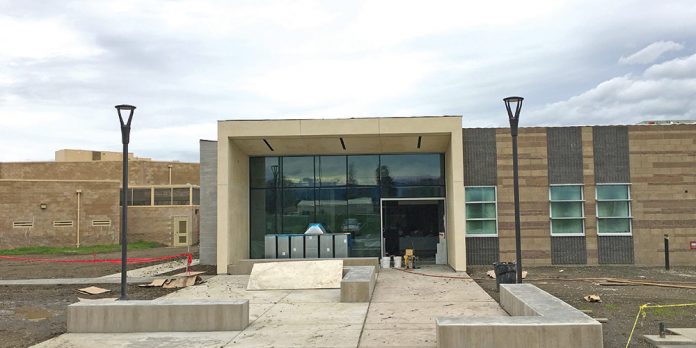The $24.5 million expansion of the San Benito County Jail is nearing completion despite some weather-related delays this winter.
Construction on the jail expansion—designed to prepare inmates for re-entry into society rather than simply keep them incarcerated—on Flynn Road in north Hollister is about 91 percent complete, according to San Benito County Sheriff’s Capt. Don Bradley.
Originally expected to be complete in April, the project is almost two months behind schedule due to “moisture content in the air and mud on the ground throughout the unusually wet winter,” he said.
The current expected completion date is June 9, Bradley said. From there, the “best guess” is the sheriff’s office will in July gain notice to occupy the new jail building from county supervisors and the state fire marshal. Construction began in late 2017.
The larger jail will require more county corrections staff. The San Benito County Board of Supervisors approved two new full-time corrections positions to staff the jail in the current county budget. The sheriff’s office has said they need five more officers to appropriately staff the jail, and expects the county to provide such staffing as the facility becomes fully operational.
The current jail has a staff of 26 full-time employees, according to the county’s 2017-18 budget.
The sheriff’s office is in the process of hiring three full-time corrections deputies, one of which is an existing vacant position, Bradley said.
Another delay is related to an off-site vendor’s production of an “anti-climb mesh wire” that will be installed around the outdoor recreation yards in the new facility, Bradley said. The county was recently told the vendor would manufacture this material at the end of April, but this is the third time the item has been delayed.
The 25,000-square-foot jail expansion, a podular design, is directly next door to the county’s existing facility, which is routinely filled to its full capacity of 142 inmates. A breezeway will connect the two buildings. Once the expansion is open, the county will have a total jail capacity of 214.
Authorities “do not anticipate running this facility at full capacity right away” due to its prioritization of rehabilitation over incarceration, Bradley explained. A small group of inmates will be selected by county corrections staff to give the new facility a “test drive” after it is cleared to open. These inmates will be selected based on past good behavior, and on their willingness to be productive citizens.
“Keep in mind that the purpose of the new facility is rehabilitation and preparation for re-entry back into the community,” Bradley said. “So the inmates selected for this (test run) will be screened for their desire to participate in education, or job skills training in an effort to reduce recidivism and promote a successful return to a productive live without…criminality.”
The new facility will contain new space for health services for inmates, classrooms and outdoor recreation yards.
A challenge in the design and budgeting of the new facility has been the control room technology. The control room in the current facility is at the end of its life, with jail staff often having difficulty replacing broken parts, Bradley said. The expanded jail will have a modern, state-of-the-art control room, but it is not compatible with the antiquated technology in the existing jail.
“We have been able to design and approve installation of a temporary fix that will allow both facilities to be operated from one control room,” Bradley said. “Unfortunately, this is not a long-term fix.”
The long-term solution involves the purchase of another technological upgrade, “but this will not occur until after we have occupied the new jail expansion and the existing contract is closed,” Bradley said.
Planning of the jail expansion began in 2007, when the county received $15 million for the project under the state AB900 law. The county will contribute another $1.5 million from its reserves as a match, and earlier this month issued $8.5 million worth of certificates of participation (COPs) to finance the remainder of the project’s cost.
The COPs will utilize a “lease/leaseback” arrangement with the San Benito County Financing Corporation to gain the needed funds, explains a Feb. 5 county supervisors staff report.










